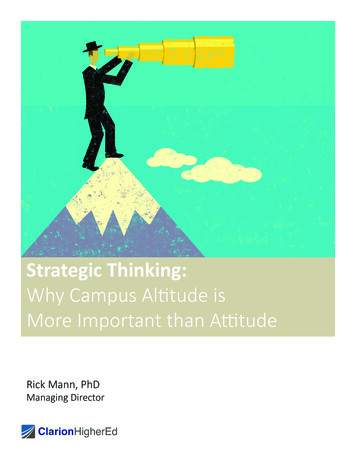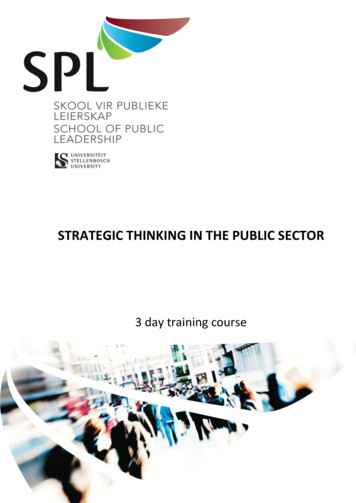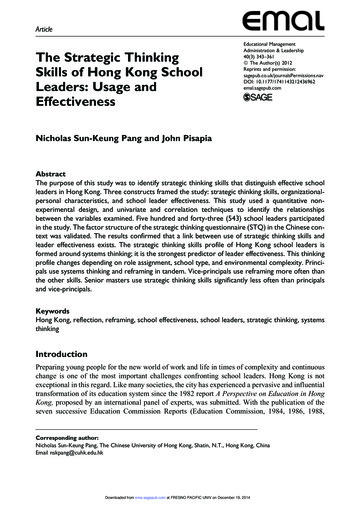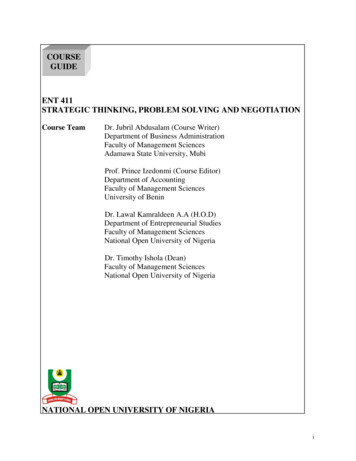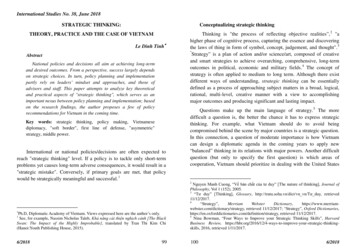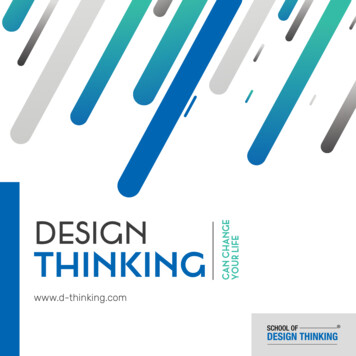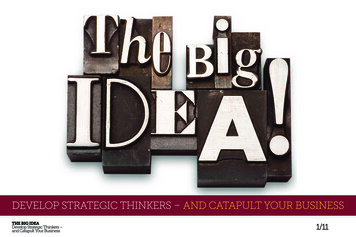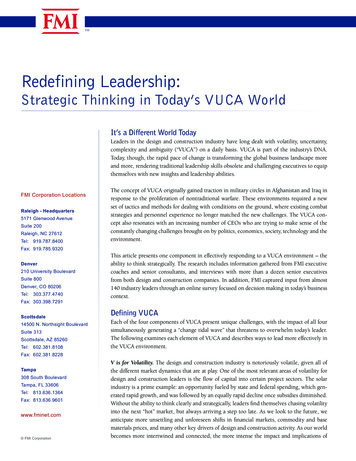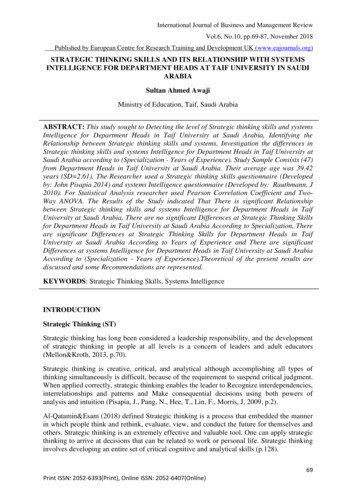
Transcription
Strategic Leadership & StrategicThinkingA Self-Guided Learning Module
Learning ObjectivesIn this self-guided learning module, you will: Learn a model which can be used to grow as a strategic leaderDiscover the integrated components of strategic leadershipExplore the key elements of strategic leadership, including strategic thinkingLearn a model which can be used to grow your strategic thinking skillsBe introduced to tools aligned with growing skills in each component of thestrategic thinking modelDiscover six habits of successful strategic thinkers and six approaches todevelop your strategic thinking skillsDiscover what you, as a manager, can do to develop strategic thinking inyour staff2
UC Core Competency ABCsToday’s learning points as related to theCore Competencies of: Change Agility – In order to be ready forleveraging the opportunities that the futurehas to offer, we must grow our strategicleadership and strategic thinking skills Mission and Vision Focus – As anemployees of a world-class learninginstitution, it is the responsibility of allUC Berkeley employees to grow ourstrategic leadership and strategicthinking skills to remain effectivein our work3
Berkeley People ManagementKnowledge AssessmentYou may wish to go deeper byidentifying your current knowledge(specific to UCB) in nine criticalpeople management areas bycompleting the UC BerkeleyPeople Management Assessment: Compensation and ClassificationComplaints and GrievancesDisciplinary ActionHealth and SafetyLeave and Disability ManagementPayroll and TimekeepingPerformance ManagementPersonnel Policies and ContractsRecruiting and gement-knowledge-assessment4
Risk ManagementAs employees of the University, we all have the responsibility to be stewards ofthe public’s resources. With this in mind, every Berkeley People Managementworkshop works helps us to mitigate risk to the campus.From the campus’ perspective, programs like this impact overall employeesuccess because well-trained, well-informed managers engage with their teamsto promote safe, equitable and stable work environments where everyone canbe successful. Through the learning opportunities you will take part in todayand through the entire BPM program series, we will engage with you to ensureyou have what you need to be successful. You will be able to spot potentialissues and mitigate them sooner, and you will know the proper procedure foridentifying and addressing challenges and issues within your teams. Morebroadly, this multi-level program creates the necessary foundation for building alearning culture on campus, and today’s program is the start of that foundation.5
What is Strategic LeadershipIntro to Strategic Leadership & Strategic Thinking6
Words of WisdomDr. Al Vicere of Vicere Associates, Inc. and the Pennsylvania StateUniversity has created a strategic leadership model that beautifullydemonstrates how leaders can implement strategic thinking into theirleader profile. Watch the video to learn more: What is Strategic Leadership7
Strategic Leadership ModelLook OutLookAroundLook tothe TeamLook forResultsLook intheMirrorSource: Dr. Al Viceresee more: https://www.youtube.com/watch?v 6y9rKebJOtY8
Strategic LeadersStrategic leadership is about diagnosing patterns and focus. This isdone by successfully: Looking out Think Mark Twain: “History don’t repeat itself, but often it rhymes.” Industry patterns tell a story, don’t miss the patterns; see the storyLooking around Think Albert Einstein: “The significant problems we face cannot besolved at the same level of thinking we were at when we created them.” Look for growth and success, what do those organizations look like9
Strategic Leaders(cont’d)And by: Looking in the mirror Think E.M. Estes: “Leadership is the courage to admit mistakes, thevision to welcome change, the enthusiasm to motivate others, and theconfidence to stay out of step when everyone else is marching to thewrong tune.” The role of a 21st century leaders is getting results and buildingcommitmentBe a boundaryless thinker, a network builder, a diplomat, and aninterpreter10
Strategic Leadership: AnIntegrated PerspectiveSource: Vicere Associates, Inc.11
Key ElementsStrategic Thinking Think Outside-In: Often leaders start by thinking of themselves, then competition, and lastlymarketplace Strategic thinkers always think from the outside-in and avoid thinking inreverseStrategic Intent Develop a purpose, build a plan, have patience, be persistent Don’t only develop a purpose, you must declare a purpose Plan with a long-term perspective Focus on corporate core competencies Always evolve12
Key Elements(cont’d)Culture Building There are three elements necessary to build culture: Commitment;Competency; Consistency Remember, what gets measured is what drives focus, what gets rewarded iswhat gets repeated13
Words of WisdomDuring an interview with Wharton management professor MichaelUseem, Sam Palmisano discusses the sale of the company’s personalcomputer business, the PricewaterhouseCoopers acquisition, how a bigcompany can encourage innovation, and what he learned from hismentors, among other observations drawn from almost 40 years atIBM. Watch the video to learn more: Sam Palmisano Interview14
Strategic ThinkingNow that we have seen the big picture, let’s dig a bit deeperinto element one.15
The FMI Strategic ThinkingModelThe FMI Strategic Thinking Modelincludes eight different components,all influenced by the individual ororganizational vision.Source: FMI Management Consulting16
Breaking Down the ModelMental Flexibility Learning how to “roll with the punches” This involves accepting your behavioral history, identifying places whereyou can compromise, practicing flexible actions, setting goals,rewarding the wins and set-backs, and learning that failure is functional Mental flexibility can be developed by: Changing the context Trying something new Questioning your initial reactions Being spontaneous with purpose, and Thinking in deliberate as well as unfocused ways17
Breaking Down the ModelIntellectual Curiosity Ask “why” (the 5 Whys Method from MindTools) This involves exploring, analyzing, and evaluating to get beyond the firstlayer or two of answers Intellectual curiosity can be develop by: Taking a set amount of time each day to investigate some new issueor topic Setting aside time to question random aspects of the world Learning both sides of a story that you think you have already madea decision about18
Breaking Down the Model(cont’d)Creativity Thinking “out of the box”Being creative often involved immersing yourself in a problem, looking broadlyfor connections, letting your ideas incubate, having a breakthrough, and pilotingone or two of your ideasCreativity can be developed by: Gaining deep expertise Taking risks Dedicating time for creative thinking, and Working to overcome negative attitudes and fearTry the Six Thinking Hats technique, a framework that can be used to inspirecreativity from de Bono NOTE: this tool has been adapted for use at UC Berkeley and can be foundon page 68 of our Team Building Toolkit)Learn more by viewing this course on Creative Problem Solving19
Breaking Down the Model(cont’d)Intuition “Reading your gut” This involves a set of non-conscious cognitive and affective processes,the outcome of which is often difficult to articulate and is not based ondeliberate thinking Intuition works in an associative manner: it feels effortless (even thoughit does use a significant amount of brain power) and it’s fast Because intuition stems from the brains ability to pick up patterns, it isoften thought of as a domain-specific ability that gets better withpractice, so offering people chances to gather deep learning about atopic and time to practice quick thinking can often be used to furtherdevelop the skill20
Breaking Down the Model(cont’d)Analysis “Reading” a situation This involves ones ability to carefully study something to learn about it Analytical skills can be improved by taking the time you need to observea situation, paying very strict attention to what’s going on around youand internally reporting it back, and reflecting on an experience the dayafter it happens to try to remember the details This trains your brain to start to think of things in a formal, analytical way21
Breaking Down the Model(cont’d)Systems Thinking Understanding the pieces This involves a holistic approach to analyzing a situation that focuses onthe way all of the parts interact with and impact each other A great overview of systems thinking is outlined by Daniel Aronson inhis short white paper titled “Overview of Systems Thinking”22
Breaking Down the Model(cont’d)Information Gathering Getting in the “know” An effective information gathering strategy should follow a definedprocedure: Analyze the problem Identify the search area Plan the search activities Adapt the search methodology to the appropriate, available tools Carry out the search Review of the records kept during the entire process Information gathering skills can be strengthened by establishing a clearfocus, intentionally exploring diverse information sources, and stayingflexible enough to accommodate different search tools and unexpectedresults23
Breaking Down the Model(cont’d)Decision Making Pushing go! An effective decision making strategy should follow a defined procedureas well: Listing possible solutions or options Setting a time scale and assigning responsibility Information gathering Weighing risks Deciding what’s important Weighing the pros and cons of each action Making the decision Decision making skills are often developed through knowledge andpractice. Take the How Good is Your Decision-Making Quiz to learnmore about your competency and style.24
Six Habits of SuccessfulStrategic ThinkersAnticipate Don’t just look directly ahead, look for and act on ambiguous signals Look for game-changing information at the periphery of your industry Search beyond the current boundaries of your business Build wide external networks to help you scan the horizonThink Critically Question everything, don’t just accept the safe opinion Reframe problems to get to the root causes Challenge current beliefs and mindsets, including your own Uncover hypocrisy, manipulation, and bias in organizational decisionsSource: Inc.com25
Six Habits of SuccessfulStrategic Thinkers(cont’d)Interpret Synthesize information from many sources before developing a viewpoint Question prevailing assumptions and test multiple hypothesessimultaneously Seek patterns in multiple sources of data Encourage others to do the sameDecide Avoid “analysis paralysis” Carefully frame the decision to get to the crux of the matter Balance speed, rigor, quality and agility, sometimes leaving perfectionbehind Take a stand even with incomplete information and amid diverse viewsSource: Inc.com26
Six Habits of SuccessfulStrategic Thinkers(cont’d)Align Foster open dialogue, build trust and engage key stakeholders Understand what drives other people's agendas Bring tough issues to the surface, regardless of how uncomfortable itmakes you Assess risk tolerance and follow through to build the necessary supportLearn Seek out honest feedback Encourage and exemplify honest, rigorous debriefs to extract lessons Shift course quickly if you realize you're off track Celebrate both success and (well-intentioned) failures that provideinsightSource: Inc.com27
Approaches to DevelopStrategic ThinkersImmersion Provide opportunities for total immersion into an area or task in order for the individualto master the core dynamics of each new situationHaving a through understanding of the situation is essential to successful strategicthinkingApprenticeships Work closely with experts in apprenticeship-like relationships in order to learn fromthose who have already mastered the skillThe learning that comes from watching someone who has mastered a skill will quicklybuild your skill and confidenceSimulations By participating in active learning situations that use simulations, individuals can beplaced in “manageably complex” environments in order to safely experiment and gaininsight into cause-effect relationshipsThis insight is crucial in developing strategic thinking skillsSource: Harvard Business Review, 128
Approaches to DevelopStrategic Thinkers(cont’d)Game Theory Training Game Theory is the study of “games” involving intelligent actors with conflictinginterests who can make moves and countermoves that yield specific potential payoffsSimilar to simulations, these games are another form of active learning and practicingnew skills within low risk situationsLearn more by taking this course on Game TheoryCase-based Education Like Game Theory training and simulations, case-based education is an activelearning technique that cause the learner to reflect on the experiences presented incase study write-ups in order to absorb the lessons and practice translating decisionsmade in the case to their real life situationsCognitive Reshaping Doing mental exercises that create new habits of mindMany of the techniques mentioned previously are designed to do this, reshape yourthinkingSource: Harvard Business Review, 129
What Can Mgmt Do to FosterStrategic Thinking Encourage your team to set a regular time aside for strategic planning (aloneand in meetings with others) Provide information to your team on the market, the industry, customers,competitors, and new technologies that influence your business Keep your team informed on what is happening internally Connect members of your team with mentors Communicate a well-articulated philosophy, mission, and goal statementthroughout your team, unit, and department Reward people for evidence of thinking, not just reacting Promote a future perspective for employees by incorporating it into trainingand development programs Teach people what strategic thinking is and encourage them to ask “why”and “when” questionsSource: Harvard Business Review, 230
ResourcesQuoted ResourcesAdditional Resources Vicere Associates, Inc.Sam Palmisano InterviewFMI Management ConsultingThe 5 Whys Method from MindToolsSix Thanking Hats Technique from de BonoUCB Team Building Toolkit – page 68Creating Problem SolvingOverview of Systems ThinkingHow Good is Your Decision-Making QuizInc.comHarvard Business Review, 1Game TheoryHarvard Business Review, 2 Korn Ferry – Strategic MindsetThree Keys to Improving Your StrategicThinkingModel ThinkingStrengthen Your Strategic Thinking MusclesUC Berkeley Transferable Skills Library –Critical ThinkingUC Berkeley Transferable Skills Library –Strategic PlanningLinkedIn LearningCEB GartnerNCCIBerkeley People Mgmt ProgramBPM: Executive Coaching ProgramUC Berkeley Executive Education31
My Action PlanNow that you have completed this course, make an action plan containing bothaction items that you will do back on the job to develop your strategicleadership and strategic thinking skills. Be sure to include a time frame, to helphold yourself accountable for doing what you plan.Action ItemTime Frame1.2.3.4.5.32
Explore the key elements of strategic leadership, including strategic thinking Learn a model which can be used to grow your strategic thinking skills Be introduced to tools aligned with growing skills in each component of the strategic thinking model Discover six habits of successful strategic thinkers and six approaches to
